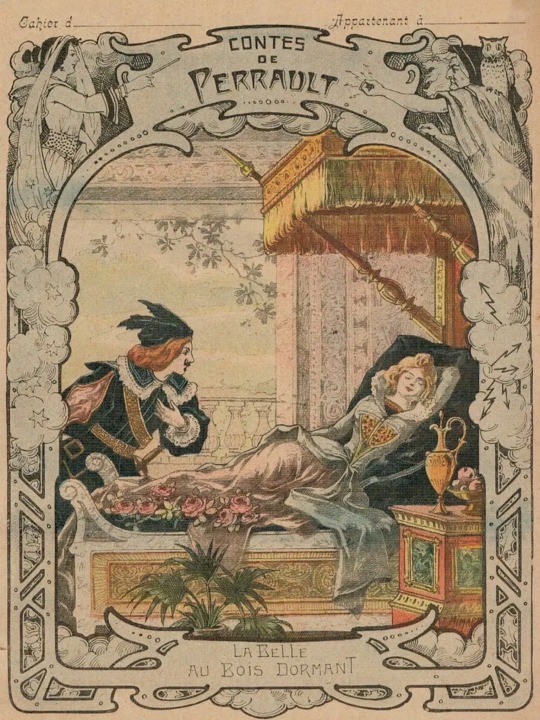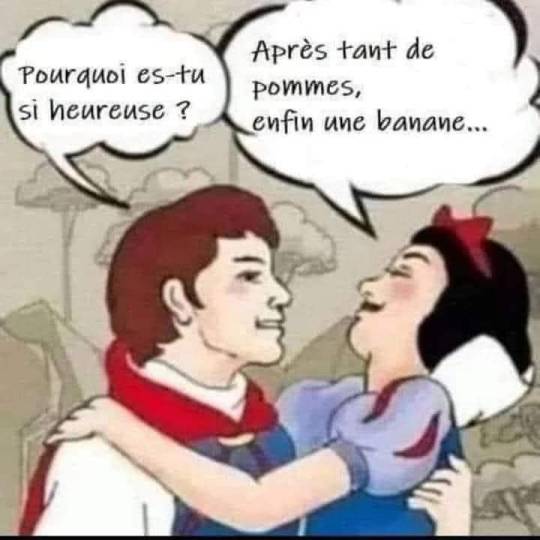#Belle au bois dormant
Explore tagged Tumblr posts
Text
La Belle au Bois Dormant
Marc : "C'est un baiser qui réveille la Belle au Bois Dormant !"

#miraculous ladybug#miraculous#adrien agreste#marinette dupain cheng#chat noir#ladybug#ml thoughts#miraculous spoilers#ml analysis#Adrien is sleeping beauty#Adrien Agreste is a Disney Princess#miraculous floconfettis#Belle au bois dormant
19 notes
·
View notes
Text

i watched sleeping beauty recently and since it’s my favourite disney princess i tried to draw her
5 notes
·
View notes
Text

The Sleeping Beauty
Artist : Henry Meynell Rheam (1859-1920)
263 notes
·
View notes
Photo


La Belle au bois dormant (Lucien Nonguet & Albert Capellani, 1908)
47 notes
·
View notes
Text

another TPTM OC done! This one is named Briarbush Girl (real name Yuèjì Dornberg) her song is about how she uses fairytales to cope with trauma. She is prickly and distrustful, shutting people out because she doesn't want to give her "curse" to them. She feels like a princess locked away in a tower, waiting for someone to save her from her "curse".
I had a hard time picking out her colors but I ultimately decided to go for just pink. I feel like I got a bit lazy and messy with her so I'm not exactly very proud of her. The pattern on her stockings are supposed to be a thorn-like pattern. If you draw her you can also simplify the rose pattern on her skirt since I just slapped a FireAlpaca rose brush pattern on her skirt.
She would be voiced by ROSE (either her CeVIO vb or her SynthV vb)
#ozzie's chickenscratch#tptm#tptm oc#the post traumatic manifesto#the post-traumatic manifesto#the post traumatic manifesto oc#the post-traumatic manifesto oc#sleeping beauty#dornröschen#la belle au bois dormant
16 notes
·
View notes
Text
I’ll probably never not get into a brain tizzy over Disney’s claim that their Sleeping Beauty is based on Perrault’s “la belle dormant.”
I suppose it’s similar in some regards — it has a “Christening” of sorts and fairies (even if earlier Grimm drafts did too). The fairies put everyone to sleep after the curse takes effect. (Everyone falls asleep in Grimm too; both take time to describe the frozen and silly tableau of sleeping people and animals.)
But where Disney’s deviates from Perrault — 100 yr sleep vs a few hours; waking up when the prince kneels by her bed vs waking up when the prince kisses her (Grimm); ogress mother-in-law vs happy ending right after kiss (Grimm). So...
Celebrating birth = Perrault
Fairies = Perrault (& early Grimm)
Up a tower & spindle (Grimm)
Fairies put everyone to sleep (Perrault)
Deadly looking briars (Grimm)
Awaken by a kiss (Grimm)
Ends soon after (Grimm)
What I think bugs me is that the parts that match Perrault are in Grimm too. In earlier drafts, the Grimms had fairies too, I believe.
Key defining feature of Perrault’s version:
Christening
Fairies
100 yr sleep
Prince kneels -> awakes
Ogress mother-in-law
Key defining features of the Grimms' version:
Frog
Spindle on the top of a tower
Briars of death (impaled princes 👍 love the imagery)
Kiss -> awakes
Both include:
An entire castle asleep
#disney#sleeping beauty#brothers grimm#charles perrault#wsd pedantic brain#wsd opinion piece#fairy tales#wsd weird brain#sorry disney i know your credits say its based on perrault but the structure is so different from what you do when grimm is right there#la belle au bois dormant#dornröschen#rambling post#hopping queue
16 notes
·
View notes
Text

Aizawa as ✨️The Sleeping Beauty✨️
(Sorry i can't stop laughing..)
#my hero academia#art#bnha#mha#drawing#my art#boku no hero academia#aizawa shota#shouta aizawa#the sleeping beauty#la belle au bois dormant#mha fanart#fanart
24 notes
·
View notes
Text
People frequently talk about the presence of a dragon in Sleeping Beauty - wondering if it is was the Disney movie that invented this concept, if there were cultural precedents to it, or what were Disney's influences if any they were.
Well here's a little piece to add to the puzzle if you want: there was a famous French adaptation of Sleeping Beauty where the prince had to fight a dragon to wake up the Beauty. Well, it was famous back then, today most people don't know about it, but it still is an important piece of fiction because it is tied to someone everybody still knows today: Sarah Bernhardt
Sarah Bernhardt, THE great and famous theater actress of France, the one and only super-star of the second half of the 19th century/early 20th century. She acted as the main actress and stage director of a Sleeping Beauty adaptation that was created in 1907 in her theater: "La Belle au bois dormant" by Jean Richepin and Henri Cain (a duo who had previously worked on Massenet's Cendrillon stage adaptation). This play (a "féerie lyrique" in verse, one prologue, two parts, fourteen tableaux ; all in alexandrins but switching between singing parts and talking parts) was a HUGE success of the time, beloved by both the audience and the critics (Sarah Bernhardt's presence certainly did help, as anything she was in was bound to be a success). It was remember as one of this works that tried and managed to bring a "féerie totale", this desire to create a féerie show where the literary aspect would be just as important and powerful as the musical and theatrical aspects.
In fact, this is what has been doing the success of the play, as some people analyzed: it both spoke to the audience who was in need of huge marvels and powerful supernatural on stage, desiring big-budget "féerie" shows (the play had TONS of singers, dancers, actors, etc, and the sets and props were done by famous craftsmen of the time) ; and to a certain part of people who were complaining that shows were becoming purely "visual" entertainment and "ocular" performances without any actual quality writing or literary effort in there. This show was both a big-budget special-effect feast, AND an effort at being a literary and cultured creation (it gathered and synthetized the many stage-adaptations of Sleeping Beauty of the 19th century - as it had been frequently adapted in theaters - with references to Shakespeare, La Fontaine, Banville and more... (Some have pointed out how the over-saturation of tropes, references and inspirations might have played a part in the show being forgotten, because once Bernhardt was out, it felt like a kitch performance mixing too-obscure references with a superficial fairytale melting pot... anyway).
The prince in this play (played by Sarah Bernhardt herself, since she adored playing "cross-dressing" roles) doesn't just cross the briar forest, he actually has to face three different trials (people have noted an influence of Wagner's creation in the sequence, like his Siegfried and Parsifal). And the first of these trials is a huge dragon. It is the eighth tableau: in "le bois des épouvantes" (the wood of terrors), under loud thunder, in the "half-day of a sinister and greenish twilight"), the prince fights and kills a fire-spitting dragon (later the text evokes a "green dragon spitting red fire", seemingly continuing from the visual color clash).
If you are curious about the other trials, the prince then is literaly englued in a soporific darkness (it is compared to pitch and glue), and as he falls asleep a Demoness/Enchantress appears. She tries to distract him away from his quest by invoking "nymphs with bodies of flowers" and "nymphs with bodies of flames", who perform a flower-fire lascivious ballet representing the "venomous wine-dreams" they send the prince, the Enchantress trying to snatch a kiss from him - but the prince shakes off the lustful illusions and the demoness and her nymphs disappear.
The last trial is at "le lac de désespérance" (the lake of despair - or rather "the lake of despairing"). There, he encounters grey, aetherial women formed out of the mists and fogs over the lake - they are alternatively called "undines" and "the sirens of oblivion", and they perform a sorrowful, sad and haunting melody, with a song about despair, death and eternal rest, inviting the prince to... well to suicide. But the prince refuses the call, refuses to get in the water. The undines disappear in the fog - and when the mist gets away, the Sleeping Beauty's castle is revealed in the light of dawn. The prince then just walks on the waters of the lake like some sort of new Jesus, to go save the princess...





#sleeping beauty#la belle au bois dormant#sarah bernhardt#french things#la belle au bois dormant 1907#sleeping beauty adaptations#dragons in fairytales
15 notes
·
View notes
Photo

The Fairy casts a spell on the inhabitants of the castle by Henri Thiriet (Engraving)
#art#artwork#kunst#kunstwerk#henri thiriet#artist#künstler#mythical art#mythische kunst#mystical art#mystische kunst#fairy tale#märchen#sleeping beauty#dornröschen#la belle au bois dormant#fairy#fee#bad fairy#böse fee#spell#zauberspruch#castle#schloss#people#menschen#sleeping#schlafen#curse#fluch
7 notes
·
View notes
Text

Programme officiel des ballets et opéras russes de Serge de Diaghilew : Théâtre national de l'Opéra, quinzième saison russe, mai-juin 1922 : [soirée du 18 mai 1922]
Opéra national de Paris
Monographie imprimée
Carnaval : ballet pantomime en 1 acte Chorégraphie de Michel Fokine Paris : Théâtre national de l'Opéra 04-06-1910
Le mariage de la belle au bois dormant Chorégraphie de Marius Petipa Réglée par Nicolas Sergeev et complétée par Bronislava Nijinska Paris : Théâtre national de l'Opéra 18-05-1922
Renard : ballet burlesque avec chant d'après des contes populaires russes Chorégraphie de Bronislava Nijinska Paris : Opéra de Paris-Palais Garnier 18-05-1922
Danses polovtsiennes du Prince Igor Chorégraphie de Michel Fokine Paris : Théâtre national de l'Opéra 07-06-1910
#talking#concert program#bnf#ballet#burlesque#opera#pantomime#set design#costume design#opera national#opera de paris#opera national de paris#palais garnier#theatre national de l'opera#apres-midi d'un faune#l'apres-midi d'un faune#prelude#barbe-bleue#bouffons#carnaval#chout#chout (le bouffon)#bouffon#le bouffon#contes russes#danses polovtsiennes#danses polovtsiennes du prince igor#prince igor#invitation a la valse#mariage de la belle au bois dormant
2 notes
·
View notes
Text


La belle au bois dormant / Sleeping Beauty
#sleeping beauty#La belle au bois dormant#charles perrault#fairytale#children's literature#fairy tale#vintage illustration#fairy story#old illustration#art nouveau#jugendstil
152 notes
·
View notes
Photo


La Belle au bois dormant (Lucien Nonguet & Albert Capellani, 1908)
17 notes
·
View notes
Text

2 notes
·
View notes
Photo


La Belle au bois dormant (1908)
2 notes
·
View notes
Text

Ne pas confondre la belle et la bête

Et la belle au bois dormant
12 notes
·
View notes
Text
🇫🇷 A Drawing A Day Juillet 2024 Jour 4.
Aujourd'hui voici Aurore, la blonde par excellence du conte de La Belle au Bois Dormant, connue pour être la princesse qui a le moins de dialogues de tous les films Disney.
◽◽◽
🇬🇧 A Drawing A Day July 2024 Day 4.
Today here is Aurore, the quintessential blonde from the tale of Sleeping Beauty, known for being the princess with the fewest lines of all the Disney movies.
◽◽◽
🇪🇦 Un Dibujo Al Día Julio 2024 Día 4.

Hoy aquí está Aurore, la rubia por excelencia del cuento de La Bella Durmiente, conocida por ser la princesa con menos diálogos de todas las películas de Disney.

#cafegaudi#a drawing a day#princesse Disney#disney princess#aurore#la belle au bois dormant#sleeping beauty#bella durmiente#toldendegrangaudi#tolden_ln#tolden#fanzine#grangaudi#art challenge#art challenge 2024#july art challenge#la bella durmiente
3 notes
·
View notes